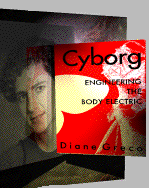


|
Stitching together the words "cybernetic" and "organism," research space scientist Manfred Clynes created the term 'Cyborg' in 1960. Cyborgs have been familiar figures in science fiction for quite some time, but since access to cyberspace has become possible for the masses, the notion of the cyborg has become more and more "real." Once we enter cyberspace, aren't we all cyborgs, technologically enhanced and extended bodies? How does this change our notions of self and personal identity? Diane Greco's hypertext "Cyborg--Engineering The Body Electric," addresses these pressing questions by animating the cyborg in the medium of hypertext. Greco wrote "Cyborg" using the hypertext authoring system Storyspace, created by Jay David Bolter, Michael Joyce and John B. Smith and published by Eastgate Systems. She uses the image of the cyborg in the works of 20th-century authors--such as William Gibson, Thomas Pynchon and Philip K. Dick--to explore cyborgs as a metaphor for personal identity and political action. Recent feminist theory and literary deconstruction are effectively used as tools to examine how the technologies used to re-configure bodies become themselves manifestations of the changing attitudes towards bodies. As Greco points out, the reconstruction of the self as cybernetic requires a reconsideration of the boundaries between the body and the machine--the technologies that invade, colonize, deform or enhance the body. Cyborgs can define themselves without insisting on the traditional boundaries that separate humans from their technology. This self-definition calls the traditional binaries of self/other and human/machine into question; the human exclusivity of the Cartesian "I think, therefore I am" becomes debatable and gains new meanings.  In a section entitled "Your Body is Meat," Greco explores cyberpunk's separation of mind from body. In cyberspace, the mind is a commodity--cowboy hackers such as Case in Gibson's Neuromancer travel in cyberspace with their consciousness; the body is disposable. Cyberpunk's disposability of the body as "meat" raises the question whether the exploitation of bodies carries a particular moral or physical weight. Neuromancer's Molly is referred to as a "meat puppet," not a prostitute. Technology may invite us to distance ourselves from our bodies, but as Greco emphasizes, technology does not only enable a flight from the body, it also invades it: the body becomes a site of technological invasion. A cyborg connects with the technology and possesses an interface with it; cyborgs require this connection as a metaphor in their self-construction. Greco's "Cyborg" addresses topics such as "Mind, Body, Anti-Body" and "Communication & Control" and poses interesting questions: If the challenge of the ever-emerging self is the struggle to create a narrative of one's history, how can cyborgs write themselves? What is this "autobiotechnography"? And what do cyborgs know? As Greco puts it, cyborgs know about parts, spare parts, prostheses, replacements and enhancements; cyborgs know how to stitch themselves together, physically and psychically. What makes this work so enjoyable, is that Greco effectively uses the medium of hypertext to reflect the topic she explores: as a technology of text construction that constantly de-stabilizes the boundaries of the text, re-configures, deforms and enhances it by stitching together parts, hypertext seems to be the ideal medium for an exploration of the cyborg. Jack-in and enjoy. |